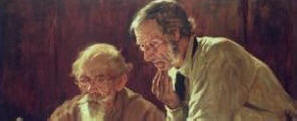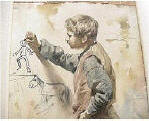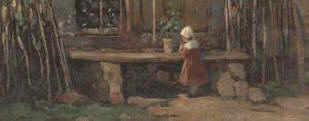|
A Day's Bag 1870
Still Life With Grapes
1871
Floral Still Life on
Marble Tabletop 1872
Pastoral Scene 1874
Ducks In Flight 1876
Woodcock Shooting
1880
Hunter's Advice 1880
Out of His Element 1883
Boy Artist 1883
At the Doorway 1883
Gen. Sheridan 1883
Woman
1883
Harriet Moody 1883
Woman
with
Head Scarf 1884
The Day's Catch 1886
Young Girl with Doll
1887
Young Girl with Fan
1887
River Landscape 1889
Man Smoking Pipe 1889
Old Man with Book 1890
Man Playing Guitar
1890
Walt Whitman 1890
Waiting for the
Fishing Party 1891
(trade card)
Waiting for the
Fishing Party 1891
Man In Straw Hat 1891
The Huntsman 1891
Cat in the Cradle 1891
After the Hunt
1892
Checking the Time 1892
The Butterfly 1893
South Horticultural Bridge
1893
North Canal Bridge 1893
Potting Flowers 1894
History of Chicago (Murals)
1902
The Eve of the Open Season
1905
Dutch Boy Painter 1907
Marsh 1908
St. Bernard Pups 1908
Solitaire 1915
|
Paintings by
Mr. Lawrence C. Earle
HISTORICAL PAINTINGS IN THE BANKING ROOM
OF THE CENTRAL TRUST COMPANY OF ILLINOIS
152 MONROE ST., CHICAGO
(Click on images below for larger views)

THE WINTER QUARTERS OF
FATHER MARQUETTE, 1674
At the mouth of the
Arkansas River, Jolliet and Marquette
encountered hostile Indians and Spaniards
who forced them to return north. Once,
there, the explorers were introduced to the
Illinois River route and the portage at
Che-cau-gou by which they were able to
return to their Mission of St. Xavier at
Green Bay. Marquette wintered at that same
portage on his second expedition to the area
in 1674-1675. |

THE FIRST FORT DEARBORN
BUILT IN 1803
As a part of the 1795
Treaty of Greenville, the U.S. government
acquired a parcel of land at the mouth of
the Chicago River from Native Americans.
Strategically important, the portage area
became even more so after the acquisition of
the Louisiana Territory in 1803, and in that
year Capt. John Whistler arrived in Chicago
to build a fort named after Henry Dearborn,
President Thomas Jefferson's secretary of
war. |

THE KINZIE HOUSE
NEAR FORT DEARBORN, 1804
When Jean Baptiste
Point DuSable sold his house and property in
the early 1800s, there was a small polyglot
community being formed, made up of transient
Miami and Potawatomi French-Indian families,
the extended Scot-Canadian Kinzie family and
a detachment of United States soldiers who
came to build Fort Dearborn. This community
remained small, numbering no more than 350
in 1833, when Chicago was incorporated as a
town. |

THE LAST COUNCIL
OF THE POTTAWATOMIES, 1833
Treaty of 1833 - In
late August 1833, more than six thousand
Potawatomi, Chippewa, and Ottawa Indians
gathered in Chicago to negotiate a treaty
ceding their lands west of Lake Michigan to
the U.S. government in exchange for a
million dollars and western reservations. It
commemorates the last and most important
Treaty held in Chicago between the Indians
and the U.S. Government, resulting in the
removal of the Chicago area Indians to the
west beyond the Mississippi River. |

THE CHICAGO RIVER
NEAR WOLF POINT, 1833
This junction of the
north and south branches of the Chicago
River was a favored subject for early
Chicago artists. In contrast to all other
illustrations known, here the view is
eastward, not to the north. The building in
the foreground is Wolf Point Tavern, with
Miller's Tavern across the river.
The
Grapeline ferry was a privately maintained
ferry service across the north branch of the
Chicago River prior to 1832, when the first
bridge was built; the ferry primarily served
patrons of the Wolf Point Tavern. |

THE FIRST BRIDGE ACROSS THE CHICAGO RIVER,
1834
In the year 1835,
Chicago, or Fort Dearborn as it was then
named, with a population near 500, was
growing a bit crowded for some tastes. Anson
H. Taylor, a young storekeeper, builder and
trader who, along with his brother, had come
out from the East, needed more elbow room.
Anson and Charles Taylor had built the first
bridge across the Chicago River three years
earlier, a wooden span connecting the south
bank of the river with the Green Bay Trail.
|

THE FIRST GRAIN ELEVATOR
IN CHICAGO, 1838
In 1839, the firm of
Newberry and Dole began shipping wheat from
Chicago's first grain elevator, which was
located at the north end of the Rush Street
bridge. The wheat was brought from farmers'
wagons, and hoisted to an upper story by
old-style pulley blocks and rope, by hand
power. |

THE GREAT FLOOD
IN THE CHICAGO RIVER, 1849
Steamboats and
schooners are bunched up in the Chicago
River during the first big flood in the
city's history. The first drawbridge had
been constructed in 1834, and was torn down
in 1839. A new floating bridge was built in
1840, and three more soon followed. All were
swept away in an 1849 spring flood, but
replacements soon followed. |

THE FIRST RAILWAY STATION IN CHICAGO, 1849
The Chicago, Burlington
and Quincy Railroad began operation in the
1840s by running a single passenger car over
recycled rails from Aurora to Chicago.
However, within the next three years, the
railroad was able to expand into the true
namesake - extending track through the
cities of Chicago, Burlington, Quincy, and
Aurora. The CB&Q became well known as one of
the finest "granger roads" or a railroad
which served agricultural areas, often
through smaller branch tracks. In 1849, the
Burlington Route staged its last spike
ceremony. Before that, they had been
operating to whatever the current end of
track was. |

CHICAGO OFFICE OF
FRINK & WALKER'S STAGE LINES, 1850
Frink & Walker
stagecoach transportation company late in
1834 bought out the stagecoach line between
Chicago and Ottawa from Winter, Mills & Co.,
which in turn had bought out Dr. John T.
Temple in February 1834; Temple had
pioneered the line earlier. Frink & Walker's
Chicago terminal was at the intersection of
Dearborn and Lake streets, one of the town's
busiest places.
By the
early 1840s, years before the first rail
lines were pushed west of Chicago, John
Frink and Martin O. Walker had already made
Chicago the center of a web of stagecoach
routes connecting the southwest tip of Lake
Michigan with virtually every important
economic region of the old Northwest
Territory. |

ILLINOIS CENTRAL RAILROAD STATION, 1856
The Illinois Central
Railroad was chartered in 1851 to build a
railroad from Cairo, Illinois, at the
joining of the Ohio and Mississippi rivers,
to Galena, in the extreme northwestern
corner of the state (the "Old Main"), with a
branch from Centralia (named for the
railroad) to Chicago. The Federal Land Grant
Act signed by Millard Fillmore in late 1850
aided the Illinois Central in becoming the
first railroad to receive a land grant. The
line was finished in 1856, giving Chicago a
route to New Orleans by way of a
railroad-operated steamboat line between
Cairo and New Orleans. |

CLARK STREET, BETWEEN
LAKE AND RANDOLPH, 1857
Historically an
important part of central Chicago, today the
James R. Thompson Center now occupies the
block bounded by Randolph, Lake, Clark and
LaSalle Streets. It is one of 35 full-size
city blocks within Chicago's Loop. Many
State of Illinois offices occupy this
distinctive building. The Clark/Lake Chicago
Transit Authority rail station, one of the
busiest in the system, is housed inside the
JRTC.
Across
Clark street is the Chicago Title & Trust
Building (Chicago Title Tower) completed in
1992. This used to be the location of the
downtown Greyhound Bus Terminal. |

THE OGDEN RESIDENCE
AFTER THE FIRE OF 1871
The Ogden mansion, on
the site now occupied by the Newberry
Library (Walton Street, between Dearborn and
Clark), was saved partly through the timely
application of carpets soaked in whatever
liquid was at hand. The New England
(Congregational) and Unity (Unitarian)
Churches, located on the east side of
Dearborn and, like the Ogden Home, facing
Washington Square Park, were both destroyed.
|

THE WORLD'S COLUMBIAN EXPOSITION OF 1893
Chicago's Columbian
Exposition of 1893 marked the rebirth of the
city after the fire of 1871; it was famous
for its "White City" that inspired the City
Beautiful movement in architecture and city
planning. Earle represented the "Great
Basin" on what seems to be his most famous
of the sixteen murals in the Chicago History
series.
He also
created two large panels for the
Manufacturers Building at the exposition.
"The Glassblowers" and "Pottery" were large
panels placed over the northeast entrance. |

THE ROCK CUT
IN THE DRAINAGE DITCH, 1899
Flooding of the Des
Plaines River overwhelmed the old Chicago
Portage and flowed into the Chicago River in
1879 . Members of the Chicago Citizens
Council, an association of civic-oriented
businessmen, demanded a permanent solution
to the City's struggle with sewage by
digging a canal deep and wide enough to
reverse the flow of the Chicago River.
On
September 3, 1892 ground was broken for the
Chicago Drainage Canal, later renamed the
Sanitary and Ship Canal. The new 28 mile
canal would run parallel to the old Illinois
and Michigan Canal for 28 miles from Chicago
to Lockport, Illinois. The new Canal would
not have the traditional system of locks,
but rather be a continuous waterway, which
engineers dubbed "the ditch." |

THE CHICAGO RIVER
AT LAKE STREET BRIDGE, 1900
Lake Street Bridge
spans the South Branch of the Chicago River.
The Randolph Street Bridge (constructed in
1865) and Lake Street Bridge (constructed in
1868) were the two major means of escape to
the west from the devastation of the 1871
fire. The Lake Street Bridge was said to
have been the only one to have survived the
fire. It was replaced in 1916 by a
drawbridge.
Historically, The first Presbyterian
services in Chicago were held when Philo
Carpenter, a Presbyterian druggist, who was
treating the troops at Fort Dearborn for
cholera, would gather his friends together
on Sundays and read a sermon. He began this
practice soon after he arrived in July of
1832. His log cabin drugstore was near the
east end of the present Lake Street Bridge. |
|



![]()















